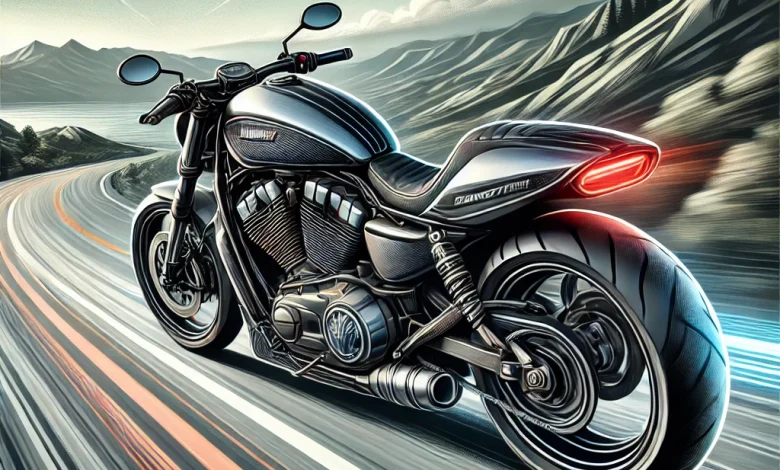Harley Sport Bike: 10 Ways Harley-Davidson is Redefining Performance Motorcycles

Table of Contents
Introduction
Harley-Davidson, a name synonymous with the legacy of cruiser motorcycles, has long been an icon in the motorcycling world. Known for its rumbling V-twin engines and timeless designs, the brand has always been associated with the open road and classic American style. However, Harley-Davidson’s recent foray into the sport bike segment marks a daring departure from its traditional roots. With the introduction of innovative models like the Harley Sportster S, Harley is challenging stereotypes and making waves in a space dominated by performance-driven machines.
The Concept of a Harley Sport Bike
A sport bike is fundamentally designed for performance, speed, and agility. Unlike cruisers that prioritize comfort and relaxed riding, sport bikes boast aggressive ergonomics, nimble handling, and high-speed capabilities. Harley-Davidson’s decision to enter this segment signifies its intent to diversify its offerings and appeal to a younger, more performance-oriented audience. Models like the Harley Sportster S exemplify this bold move, blending the brand’s heritage with cutting-edge technology and design to create a unique riding experience.
Key Features of Harley Sport Bikes
Design and Aesthetics
Harley sport bikes stand out with their aggressive stance and sporty lines, a stark contrast to the classic cruiser silhouette. Modern elements such as LED lighting, minimalistic styling, and aerodynamic components give these bikes a sleek, contemporary appearance.
Engine Performance
At the heart of Harley sport bikes lies a powerful engine designed for speed and precision. The Revolution Max engine, featured in models like the Harley Sportster S, delivers impressive horsepower and torque, redefining what Harley riders can expect in terms of performance.
Advanced Technology
Harley sport bikes incorporate advanced technology to enhance the riding experience. Features like customizable riding modes, digital displays, smartphone connectivity, and advanced safety systems such as cornering ABS and traction control set them apart in the sport bike segment.
How Harley Sport Bikes Compare to Traditional Models
Harley-Davidson’s sport bikes represent a significant shift in riding style and ergonomics. Unlike the relaxed, upright posture of cruisers, sport bikes are designed with forward-leaning ergonomics to enhance aerodynamic efficiency and agility. This design enables riders to better tackle high speeds and sharp corners, offering a thrilling and performance-oriented riding experience.
One key difference lies in the frame geometry and suspension setup. Traditional Harley cruisers are built for long-distance comfort, featuring extended wheelbases, softer suspensions, and a laid-back riding stance. In contrast, Harley sport bikes, such as the Sportster S, have shorter wheelbases and stiffer suspensions for improved maneuverability and precision handling. These characteristics make them ideal for both urban environments and spirited rides on twisty roads or tracks.
Despite these differences, Harley sport bikes retain the brand’s DNA in several ways. The robust build quality, signature V-twin engine configuration, and meticulous attention to detail are hallmarks of Harley-Davidson craftsmanship. Additionally, these sport bikes often feature design cues, such as a bold fuel tank shape or a distinctive exhaust note, that pay homage to the brand’s heritage.
The purpose of these models is another point of divergence. While cruisers are designed for relaxed, long-distance touring and a focus on comfort, Harley sport bikes cater to riders who seek adrenaline, speed, and precision. The inclusion of advanced technology, such as ride modes and cornering ABS, further sets them apart from their traditional counterparts, making them a bridge between Harley-Davidson’s legacy and its innovative future.
This evolution in Harley’s lineup opens up opportunities to reach a broader demographic, appealing to both loyal Harley enthusiasts looking for something new and younger riders eager for cutting-edge performance. The Harley sport bikes are not just a departure from tradition—they’re an expansion, blending the brand’s iconic essence with modern motorcycling trends.
Market and Audience for Harley Sport Bikes
Harley sport bikes target a younger, dynamic demographic of riders who prioritize performance, innovation, and style. This audience includes those who value speed, agility, and advanced technology, often seeking motorcycles that align with their adventurous and performance-driven lifestyles. These riders are typically urban professionals or enthusiasts looking for a versatile bike that performs equally well on city streets, highways, and twisty backroads.
Harley’s foray into the sport bike segment also caters to a global audience. In emerging markets, where sport bikes dominate due to their affordability, compact size, and performance, Harley sport bikes position the brand as a viable contender against established competitors. In Western markets, these models appeal to younger riders who might have previously overlooked Harley-Davidson due to its traditional cruiser image.
The Harley Sportster S is a standout model in this segment, praised for its versatility and ability to bridge the gap between heritage and modernity. With a powerful Revolution Max engine, a lightweight frame, and cutting-edge technology, the Sportster S appeals to seasoned riders looking for a thrilling ride as well as newcomers drawn to its approachable design and features. Its customizable ride modes, digital instrumentation, and sleek aesthetics make it an appealing choice for tech-savvy riders.
Additionally, the sport bike segment’s emphasis on individuality and self-expression aligns with Harley-Davidson’s brand ethos. This allows Harley sport bikes to resonate with riders who value both performance and the ability to stand out. By incorporating bold designs and premium features, Harley sport bikes have successfully captured attention across diverse markets, from the competitive circuits of Europe to the bustling cities of Asia and the wide-open roads of the Americas.
Global reviews of Harley sport bikes reflect this growing appeal, with riders and experts alike commending their blend of performance, innovation, and iconic styling. As Harley-Davidson continues to refine its approach in the sport bike market, it is clear that these models are redefining the brand’s identity while expanding its reach to a new generation of motorcycle enthusiasts.
Performance and Handling
Harley-Davidson’s sport bikes are engineered to excel in both road and track environments, offering a performance package that balances power, agility, and control. These motorcycles are equipped with advanced suspension systems, such as adjustable front forks and rear monoshocks, designed to provide a smooth and responsive ride even in challenging conditions. High-performance braking systems, often featuring dual-disc setups and cornering ABS, ensure confident stopping power and safety, particularly at higher speeds or during aggressive maneuvers.
A notable example, the Harley Sportster S, demonstrates the brand’s commitment to delivering a refined and thrilling riding experience. Its Revolution Max engine produces impressive horsepower and torque, allowing for rapid acceleration and sustained performance on straightaways and twisty roads alike. The lightweight chassis and low center of gravity further enhance its cornering abilities, making it a standout in the competitive sport bike segment.
Rider feedback has highlighted the Harley Sportster S’s balanced handling, precise throttle response, and overall stability. Whether navigating urban streets or pushing limits on the track, the bike’s agility and control inspire confidence. The inclusion of riding modes—such as Sport, Road, and Rain—allows riders to tailor the bike’s performance characteristics to their preferences and environmental conditions.
Additionally, Harley-Davidson incorporates advanced electronics to improve handling and rider control. Features like traction control, lean-sensitive ABS, and customizable suspension settings enhance the overall riding experience. These innovations position Harley’s sport bikes as versatile machines capable of adapting to a wide range of scenarios, from casual cruising to spirited sport riding.
By combining cutting-edge performance features with the brand’s signature build quality, Harley-Davidson has successfully created sport bikes that cater to riders seeking precision and excitement without compromising on reliability or style. This performance-focused approach underscores Harley’s commitment to redefining its presence in the world of high-performance motorcycles.
Challenges and Opportunities for Harley in the Sport Bike Segment
Harley-Davidson’s entry into the sport bike market presents both significant challenges and exciting opportunities. The brand faces fierce competition from well-established manufacturers like Ducati, Yamaha, and Kawasaki, all of whom have decades of experience in the performance-focused sport bike category. These rivals boast extensive sport bike lineups, proven track records on the road and the racetrack, and loyal customer bases.
One of the primary challenges for Harley is overcoming preconceived notions about the brand. For years, Harley-Davidson has been synonymous with heavyweight cruisers and touring motorcycles, so convincing riders that the brand can also excel in the high-performance sport bike segment requires a shift in perception. Another hurdle lies in appealing to sport bike enthusiasts who are accustomed to brands that prioritize cutting-edge technology, lightweight designs, and track performance.
However, Harley-Davidson’s unique approach offers distinct opportunities to stand out in this competitive segment. By blending the brand’s iconic design language and craftsmanship with sport bike innovation, Harley sport bikes provide a product that appeals to both loyal fans and new audiences. The Harley Sportster S, for example, has successfully combined aggressive styling, advanced technology, and the unmistakable character of a Harley, creating a compelling option for riders seeking something different from the usual offerings in the sport bike market.
The sport bike segment also provides Harley-Davidson with a chance to tap into younger, more performance-oriented demographics. These riders are drawn to motorcycles that deliver speed, agility, and advanced features, but they also value individuality and style—attributes that Harley sport bikes can deliver. By leveraging its brand heritage while incorporating modern performance and technology, Harley has the potential to carve out a niche that bridges the gap between tradition and innovation.
International markets represent another significant growth opportunity for Harley in the sport bike segment. In regions like Europe and Asia, where sport bikes dominate, Harley’s entry into this category allows it to compete with local favorites and gain a foothold in these markets. By offering a product that blends Harley-Davidson’s American legacy with global sport bike trends, the brand can attract riders who appreciate both performance and heritage.
To succeed, Harley-Davidson will need to maintain a balanced strategy. This includes continuing to innovate in the sport bike segment, providing competitive pricing, and emphasizing the unique value proposition of Harley sport bikes. Strategic marketing efforts to highlight the brand’s ability to blend performance with heritage will also be crucial in winning over skeptics and attracting new riders.
While the challenges are significant, the opportunities for Harley-Davidson in the sport bike segment are immense. By staying true to its roots while embracing the demands of modern motorcycling, Harley has the potential to redefine its identity and achieve success in this dynamic and competitive space.
Cultural Impact and Reception
The introduction of Harley sport bikes marks a transformative moment in Harley-Davidson’s long-standing history. Known for its iconic cruisers, the brand’s decision to venture into the sport bike segment challenges entrenched perceptions of what a Harley-Davidson motorcycle can represent. This bold shift signals a desire to evolve beyond tradition while still honoring its heritage.
By launching innovative models such as the Harley Sportster S, the company is successfully bridging the gap between its classic identity and modern motorcycling trends. This evolution has attracted a new wave of riders—those who value cutting-edge performance, sleek aesthetics, and advanced technology. These riders may not have considered Harley-Davidson in the past due to its association with cruisers, but the introduction of sport bikes has opened the door to a broader, more diverse audience.
Loyal Harley fans have shown mixed reactions to this shift, with some embracing the change as a necessary evolution and others hesitant to see the brand diverge from its traditional roots. However, the reception from new and younger riders has been overwhelmingly positive, applauding Harley’s willingness to innovate and compete in a performance-driven market.
Culturally, Harley sport bikes are redefining what it means to own a Harley-Davidson. The brand is no longer solely associated with long highway rides and laid-back cruising—it’s now making waves in the fast-paced, adrenaline-fueled world of sport biking. This shift not only enhances Harley’s relevance in a competitive industry but also positions it as a forward-thinking company capable of adapting to changing rider preferences.
Harley-Davidson’s sport bikes are also influencing perceptions internationally. In regions where sport bikes dominate, such as Europe and parts of Asia, the launch of performance-oriented models has increased the brand’s appeal. These bikes showcase Harley’s ability to blend American craftsmanship with global motorcycling trends, creating a unique product that resonates with riders worldwide.
By merging innovation with its storied legacy, Harley-Davidson is reshaping its cultural identity and solidifying its place in the future of motorcycling. The introduction of sport bikes represents not just a new lineup of motorcycles but a broader reimagining of what the brand stands for. This cultural shift is setting the stage for an exciting new chapter in Harley-Davidson’s journey.
Conclusion
Harley-Davidson’s bold entry into the sport bike segment is not just a diversification of its product lineup but a transformation of its brand identity. By blending its storied heritage with modern innovation, Harley sport bikes like the Sportster S symbolize a seamless fusion of tradition and performance. These bikes offer an enticing alternative for younger, performance-oriented riders while staying true to the core values of craftsmanship and quality that Harley-Davidson has always represented.
While the road ahead is filled with challenges, from overcoming entrenched perceptions to competing with established sport bike brands, Harley-Davidson’s commitment to redefining itself positions it as a strong contender in this high-performance segment. With their powerful engines, aggressive aesthetics, and advanced technology, Harley sport bikes are not just machines—they’re a statement of the brand’s ability to evolve while honoring its legacy. As Harley-Davidson continues its journey in the sport bike segment, it’s clear that the brand is paving the way for an exciting new era in motorcycling.
FAQs
1. What makes Harley-Davidson sport bikes different from their traditional cruisers?
Harley sport bikes are designed for performance and agility, featuring forward-leaning ergonomics, high-powered engines, and advanced suspension systems. In contrast, traditional Harley cruisers prioritize comfort, long-distance touring, and a laid-back riding posture.
2. Which is the most notable Harley sport bike currently available?
The Harley Sportster S is a standout model in the sport bike lineup. It features the Revolution Max engine, customizable riding modes, advanced electronics, and a sleek, aggressive design that bridges Harley’s heritage with cutting-edge performance.
3. Who is the target audience for Harley sport bikes?
Harley sport bikes primarily target younger, performance-oriented riders who value speed, technology, and style. These bikes also appeal to riders seeking a modern Harley experience that differs from the traditional cruiser aesthetic.
4. How does Harley-Davidson compete with established sport bike brands like Ducati and Yamaha?
Harley-Davidson stands out by combining iconic American craftsmanship with the innovation and performance demanded in the sport bike segment. This unique approach offers riders a blend of heritage and cutting-edge technology, creating a distinctive niche.
5. Are Harley sport bikes suitable for beginners?
Yes, Harley sport bikes like the Sportster S offer a versatile design that caters to both seasoned riders and newcomers. Features like customizable ride modes and advanced safety systems make them accessible and manageable for less experienced riders.
6. What advanced technologies do Harley sport bikes offer?
Harley sport bikes are equipped with features such as lean-sensitive ABS, traction control, customizable riding modes, digital displays, and smartphone connectivity. These technologies enhance safety, performance, and the overall riding experience.
7. How have traditional Harley-Davidson fans reacted to the sport bike lineup?
The reaction has been mixed. While some loyal fans embrace the innovation and see it as a necessary evolution, others are hesitant about the shift from the brand’s traditional cruiser image. However, the new lineup has successfully attracted younger and modern riders.
8. Where are Harley sport bikes most popular?
Harley sport bikes have gained traction in both Western markets and regions like Europe and Asia, where sport bikes dominate. Their performance, combined with Harley’s reputation for quality, has broadened the brand’s global appeal.
9. Will Harley-Davidson continue to expand its sport bike lineup?
Given the positive reception of models like the Sportster S, Harley-Davidson is likely to continue innovating and expanding its presence in the sport bike segment. This evolution aligns with its strategy to attract a new generation of riders while staying relevant in a competitive industry.
10. How do Harley sport bikes perform on the track compared to other sport bikes?
While Harley sport bikes may not yet dominate the racetrack like some established sport bike brands, models like the Sportster S have been praised for their powerful performance, balanced handling, and agility, making them competitive in the segment.



